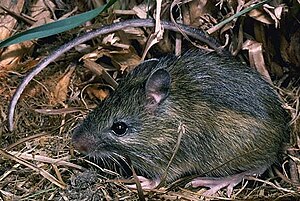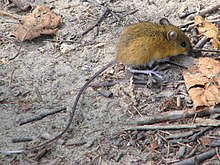Bouncy mice
| Bouncy mice | ||||||||||||
|---|---|---|---|---|---|---|---|---|---|---|---|---|

Western bouncy mouse ( Zapus princeps ) |
||||||||||||
| Systematics | ||||||||||||
|
||||||||||||
| Scientific name | ||||||||||||
| Zapodidae | ||||||||||||
| Coues , 1875 |
The jumping mice (Zapodidae) are a species-poor family of rodents , which are characterized by elongated hind legs. There are four types of the family in North America and one in China.
features
Hop mice reach a head-trunk length of 7 to 10 cm, a tail length of 10 to 16 cm and a weight of 17 to 29 g. Females are slightly larger than males. The hind legs and feet and the tail are unusually long, while the front legs and feet are normal. The fur is reddish or yellowish, forest jumping mouse and Chinese jumping mouse are more reddish, with the real jumping mice yellowish or orange tones dominate. All five species have a dark brown eel line on the middle of the back. The belly side is usually whitish, the Chinese jumping mouse has a light brown stripe on the belly. The tail is dark on top and light on the underside. The tip can be white. The incisors are colored orange or yellow.
| 1 | · | - | · | 0-1 | · | 3 | = 16 or 18 |
| 1 | · | - | · | 0 | · | 3 |
Way of life
Hop mice are mostly nocturnal, but can sometimes also be seen during the day. Their diet consists mainly of seeds and mushrooms, along with berries, other fruits, caterpillars, beetles, maggots, spiders, millipedes and worms. The composition of the food depends on its seasonal occurrence. In spring it consists of about half of various invertebrates and 20% of seeds, while mushrooms are rarely consumed. As the year progresses, the proportion of seeds and fungi in the diet increases and the consumption of invertebrates decreases. Bouncy mice survive the winter asleep. At the end of winter, the males wake up from hibernation before the females. Mating takes place immediately after the females wake up. The gestation period is 17 to 21 days. 2 to 9, in most cases 4 to 6 young animals are born per litter. Newborns are hairless and can crawl but not stand in the first week of life. The external auditory canals open when they are 20 days old, and their eyes open five days later. From then on the young animals begin to eat solid food and leave the nest. They will likely still be suckled for some time, but by four weeks of age they will be fully hairy and self-sufficient. The females give birth once or twice a year, in rare cases they also have young three times. Young animals born late often do not survive the winter because they do not have enough time to build up enough fat reserves. The nests are usually built in the ground, often only 15 cm below the surface, in open landscapes but also in tufts of grass. However, nests have also been found in trees. Hop mice usually reach an age of one to two years, in exceptional cases they can live up to 5 years.
Genera and species
There are three genera with a total of five species.
-
Real bouncy mice ( zapus )
- Meadow jumping mouse ( Zapus hudsonius )
- Western bouncy mouse ( Zapus princeps )
- Pacific bouncy mouse ( Zapus trinotatus )
-
Eozapus
- Chinese jumping mouse ( Eozapus setchuanus )
-
Napaeozapus
- Wood jumping mouse ( Napaeozapus insignis )
Systematics
The bouncy mice were long considered a subfamily of the jerboa (Dipodidae), where it was assumed that they are at the base of the jerboa. In the Handbook of the Mammals of the World , a standard work on mammalogy , they are treated as separate families.
Danger
The population of all species of bouncy mice is considered stable by the IUCN and the species are listed as Least Concern.
Individual evidence
- ↑ a b c d e Don E. Wilson , Thomas E. Lacher, Jr, Russell A. Mittermeier : Handbook of the Mammals of the World: Rodents II. Volume 7. Lynx Edicions, 2017, ISBN 978-84-16728-04 -6
- ↑ Don E. Wilson, DeeAnn M. Reeder (Ed.): Mammal Species of the World. A taxonomic and geographic Reference. 2 volumes. 3. Edition. Johns Hopkins University Press, Baltimore MD 2005, ISBN 0-8018-8221-4 .

